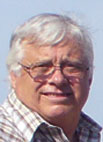
What started as a family garden in the 1970s now is a 650-acre livestock operation
Robert and Susan Salmon began their farming journey with a family garden. The couple, who married in 1974, explained it was a matter of quality over quantity at the time.
By the early 1980s, their garden expanded past the point of what their land could handle so the couple moved their family of six to a 55-acre farm near Appleton City, Mo.
Since moving to the farm in 1982, the Salmons have added to the land a little bit at a time, growing the operation to 650 acres. They now graze more than 250 head of cattle, some of which are part of a custom cattle grazing enterprise, and they raise 140 North Country Cheviot sheep.
“It’s just something I always felt I wanted to do,” Robert said. “So we started out small. This was our next step here and we’ve been fortunate enough to add ground over the years. It just keeps growing.”
Robert, a first-generation farmer, explained that his success can be attributed to the power of reading, a positive mindset and good ole trial and error.
“When we first started out, as we grew into it, we did a lot of diversified stuff,” Robert explained. “We did some row crop, we did sows and pigs and cattle. We developed over the years into a grazing operation.”
As they started to better manage their grass, Robert studied Jim Gerrish’s work with management-intensive grazing. The Salmons started experimenting with grass management by subdividing their first pasture in 1987 and Robert said that’s when his operation started to take off.
By focusing on how the grass was grazed and how much residual he was leaving, Robert saw he could grow more grass without additional inputs. This equated to more profit per acre.
“You really are able to up your stocking capacity of your whole entire farm by managing your grass,” Robert said. “Doing more with the resources you have.”
The family divided their land into mostly 10-acre paddocks with high tensile fencing for their cattle and sheep to graze. They put permanent fences into place with a small amount of temporary fence which are used on a seasonal basis. The Salmons then installed piped water sources for the livestock in each paddock.
Robert rotates the cattle and sheep before the grass becomes too short. This could be a rotation of every day or every other day, depending on the grass’s condition.
As he explained, grass cannot grow back quickly if there isn’t an adequate amount of leaf area left to capture sunlight and protect the soil. Thus proper monitoring is a vital step in the managed grazing process.
When looking at the health of the environment and soil, Robert closely monitors the area for dry conditions. In the past, the Salmons have had to sell their cattle due to a drought. His sheep are the last thing he will sell due to their resilience to a dry environment he explained.
Thankfully, so far this year his paddocks have seen enough moisture to keep them going this summer.
“We’ve been affected by three or four droughts over the years,” Robert said. “It’s just a cyclical thing. We’re dry right now. We’re not in trouble or anything, but we are dry right now.”
How the grass is cared for and the condition it is in will affect his operation year to year. Therefore Robert takes great interest in seeing how the grass responds to the soil and the environment in different conditions throughout each season.
Additionally, Robert has also had opportunities to see how well the ground will heal itself when adding onto his operation.
“We had areas that we bought that had been extensively grazed and were gullied and rutted and everything,” Robert said. “And after a few years of management-intensive grazing the gullies are gone. The grasses are better. … You see results pretty quick.”
After farming for more than 30 years, Robert understands the struggles one can endure when first starting out as well as the environmental challenges along the way. However, he explained that individuals who want to break into the farming business or management-intensive grazing should not lose hope of doing so.
“You don’t have to have a huge amount of inputs,” Robert said. “You don’t have to have a huge amount of machinery. It’s not demanding. It’s very profitable. So it’s not something you have to quit because you physically can’t do it. It’s something you can carry on with in your older years.”
When looking toward his future, Robert said he hopes to keep managing his farm under the same grass grazing techniques. And he’s also excited to see both of his sons continue to manage their own successful farming operations under the management-intensive grazing he has become so passionate about.





